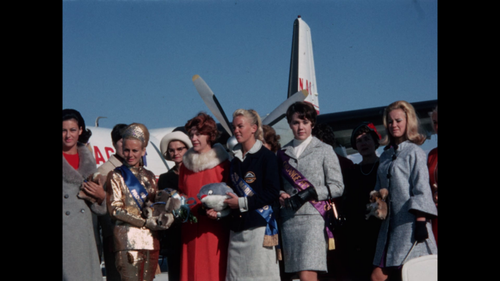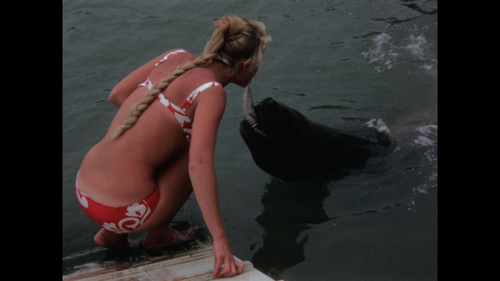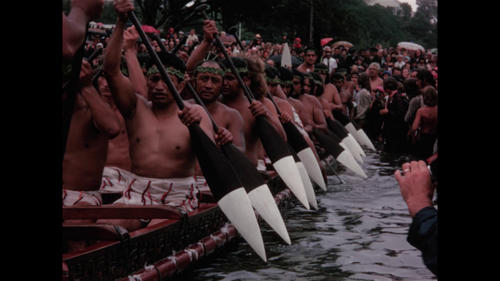
Ngā Taonga recently completed an exciting film preservation project, at the request of Tauranga City Libraries, to digitally preserve 18 charming short films by Tauranga filmmaker Norman Blackie (1899-1983).
Hero image: Still from the 'Tauranga Orange Festival 1961' - A film by Tauranga amateur filmmaker Norman Blackie.

Still from the 'Tauranga Orange Festival 1961'- A film by Tauranga amateur filmmaker Norman Blackie.
Norman worked at a sawmilling company and became involved with local community groups, which led him to put his cinematography skills to use. He captured a range of public events and celebrations for posterity. These include beauty queens performing their public duties; competitions; parades; construction works; parties; and hāngī.

Still from the 'Tauranga Orange Festival 1961'- A film by Tauranga amateur filmmaker Norman Blackie.

Still from the 'Tauranga Orange Festival 1961'- A film by Tauranga amateur filmmaker Norman Blackie.
Several of the films depict the Orange Festival, an annual event to promote Tauranga that started in 1961. Blackie was there to capture it that year and several times afterwards.
'Tauranga Orange Festival 1961'- A film by Tauranga amateur filmmaker Norman Blackie.
A note left inside the film can that held the recording reads:
‘Orange Festival 1961 – The first Orange Festival and procession with the activities in the Triangle. Fun for all and then on the Saturday the lovely procession of floats etc. Procession from Greerton along Cameron Road to the park & there we join with the Highland Games. Festivities in the park with massed Highland Bands marching and sport 1961.’

Still from the 'Tauranga Orange Festival 1961'- A film by Tauranga amateur filmmaker Norman Blackie.
In this film from 1972, we get to see the launch of the waka Te Awanui, with detailed shots of the prow carving by Tuti Tukaokao (Ngāi Tamarawaho, Ngāti Haungarau). A large crowd of onlookers follows the waka to, and even into the water, many capturing their own home movies or photographs of the big moment.
The carving and launch of a waka in Tauranga in 1972, using a modified Keystone Model A7 16mm camera - A film by Tauranga amateur filmmaker Norman Blackie
Blackie shot his films on 16mm silent film, using a Keystone Model A7 camera which he modified to switch between multiple lenses (his modified camera is now in the collection of Tauranga City Libraries).

The carving and launch of a waka in Tauranga in 1972, using a modified Keystone Model A7 16mm camera - A film by Tauranga amateur filmmaker Norman Blackie
It took a lot of skill to operate this camera, especially compared to a more modern video camera. The Keystone had a wind-up mechanism and ran at a usual speed of 16fps, although this was variable and we have noticed a few instances where the film was running through the camera slightly fast or slow. The viewfinder was slightly offset from the lens so until the film was developed the filmmaker couldn’t be completely sure what he had captured. Despite all of this, the films look great, especially after digital preservation.
Ngā Taonga holiday message 2022 - A compilation of excerpts from the Blackie Collection.
The colours are rich, the detail is crisp, and Blackie shows an eye for composition, seemingly always front and centre when something interesting was happening. Each movie offers a delightful window into mid-century life in and around Tauranga. The fashions, the homemade costumes, the eclectic parade floats and even dressed-up pets show a lot of individuality and creativity. Harley Couper of Tauranga City Libraries shared these thoughts:
‘What immediately grabs my eye when looking at the Norman’s footage, is the size of the crowds in the backgrounds. They line the streets and fill the squares, despite a population just 10% of our current. Yet Norman doesn’t often focus on these crowds, their size is nothing unusual for him. For Norman it is the spectacle itself; the floats, the costumes, the games, the beauty queens and marching girls. It seems when something is happening, half of Tauranga comes out to cheer on the other half participating.’